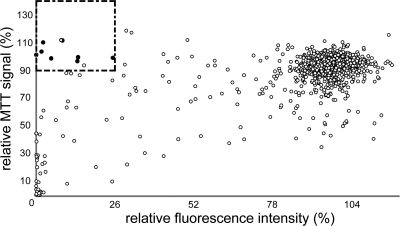FIG. 3.
Screening of a compound library for HIV-inhibitory molecules. LC5-RIC cultures were incubated in triplicates with HIV-1LAI virus and compounds of the LOPAC1280 library at 10 μM for 48 h (i.e., test cultures). Subsequently, aliquots of potentially infectious supernatants of test culture were transferred to uninfected LC5-RIC indicator cells, and fluorescent signal intensities were measured 72 h after transfer. Fluorescent signal intensities determined for samples from test cultures were normalized to fluorescent signal intensities determined for control samples (i.e., untreated HIV-infected cultures). Compound effects on the viability of cells in the test cultures were measured by MTT assay and normalized to values of control cultures. Each data point in the scatter plot indicates the value for the relative MTT signal (y axis) and the relative fluorescent signal intensity (x axis) determined for each compound. Potentially inhibitory compounds (indicated by the rectangle) were defined as compounds that decreased the relative fluorescent signal by greater than three times the standard deviation of the average relative fluorescent signal of all tested compounds (≤26%), without reducing the relative MTT signal below 90%. Filled circles represent selected compounds with known anti-HIV activities listed in the NIAID Division of AIDS HIV/OI/Therapeutics database.

